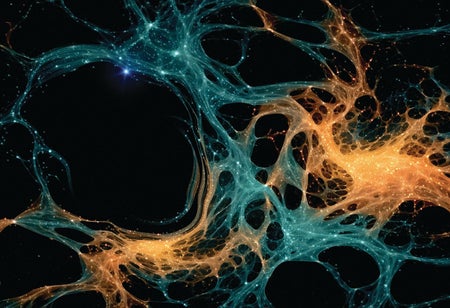
How Analyzing Cosmic Nothing Might Explain Everything
Huge empty areas of the universe called voids could help solve the greatest mysteries in the cosmos
Michael D. Lemonick is a freelance writer, as well as former chief opinion editor at Scientific American and a former senior science writer at Time. His most recent book is The Perpetual Now: A Story of Amnesia, Memory and Love (Doubleday, 2017). Lemonick also teaches science journalism at Princeton University.

How Analyzing Cosmic Nothing Might Explain Everything
Huge empty areas of the universe called voids could help solve the greatest mysteries in the cosmos

A Possible Crisis in the Cosmos Could Lead to a New Understanding of the Universe
Several unexplained measurements are threatening to upend scientists’ understanding of the universe’s origin and fate

A Meteorite Fell in Their Bedroom. Here’s What Happened Next
Earlier this month a meteorite crashed through the roof of a New Jersey home. The residents are still pondering the fate of their gift from the skies

Sometimes Science Is Wrong
Research is a self-correcting process, but that fact is often lost on the public

Coronavirus News Roundup: October 17–October 23
Here are pandemic highlights for the week

Those Precautions for Avoiding the Coronavirus May Seem Extreme, But ...
That’s the wrong way to think about them

A Vision of Ephemeral Ice
Artist Shoshannah White views the endangered Arctic ice through a unique lens

Chemistry Can Be More Fun than You Think
A first-year college student has rebooted the periodic table of the elements in a whimsical and compelling way

An Open Letter Endorsing the Global School Strike for Climate
More than 240 scientists have already signed a document supporting students around the world in their demand for bold action to make sure the world they grow up in is livable

Requiem for a Revolutionary Space Probe
The Kepler Mission introduced us to a dazzling array of solar systems

The Magic of the Microscopic World
Biologist and teacher Carrie Norin uses photography to reveal the unseen beauty around us

A Brain Deprived of Memory
Michael Lemonick, opinion editor at Scientific American, talks about his most recent book, The Perpetual Now: A Story of Amnesia, Memory and Love, about Lonni Sue Johnson, who suffered a specific kind of brain damage that robbed her of much of her memory and her ability to form new memories, and what she has revealed to neuroscientists about memory and the brain.

Women in Science are a Force of Nature
Cast your vote for the unsung and insufficiently sung female heroes of science for a celebratory poster series from the Perimeter Institute

Inflating the Universe with Prize-Winning Cosmologist David Spergel
This year’s Breakthrough Prize in Fundamental Physics was awarded to the team behind NASA’s Wilkinson Microwave Anisotropy Probe, or WMAP, a space telescope that launched in 2001 to map the cosmic microwave background—the earliest, oldest light we can detect from the universe’s infancy. The WMAP team will split the $3 million award, with its leaders receiving the largest shares. One of those leaders, WMAP’s chief theorist David Spergel, sat down to speak with Scientific American about WMAP’s science and its legacy.

Neutron Star Collisions Create Gold
Astrophysicists searching for gravitational waves have finally learned what happens when you crash two neutron stars together--and it's very, very shiny.

Gravitational Waves: A Love Song
Science songwriter Adam Sakellarides strikes again

Witness the Solar Eclipse without Frying Your Eyes or Your Camera
America is preparing for a sea-to-shining-sea solar eclipse. Here’s how you can watch the spectacular display, and maybe even snap a photo to commemorate the event, without burning your retinas or damaging your camera’s optics.

How to Weigh a Star Using Gravitational Lensing
Astronomers recently tapped Einstein's concept of gravitational lensing to determine the weight of a distant star. Watch and learn how this concept came to be and how it works.

The Art of Science
A printmaker takes on the greatest scientific questions of the 21st century

Interstellar Projectiles Zoom around Us at Blistering Speeds
Hypervelocity stars, and the black holes that launch them, whip through space at millions of miles per hour.

The 10 Weirdest Things in the Solar System
Pierogi moons, rubber duckie comets and spewing ice balls: We have some very strange neighbors among the myriad planets, moons and objects that circle our sun.

A Tasty Trove of Exoplanets at TRAPPIST-1
A baker’s half-dozen of Earth-size worlds is orbiting a (relatively) nearby star—and some could be habitable

Planet Formation out of Black Hole Belches
New studies suggest lonely planets flying through intergalactic space were formed by star-destroying supermassive black holes.

Forget Me Not: The Harrowing Tale of H. M.'s Brain [Excerpt]
Michael D. Lemonick explains how a postmortem study of the most celebrated amnesic in history went awry